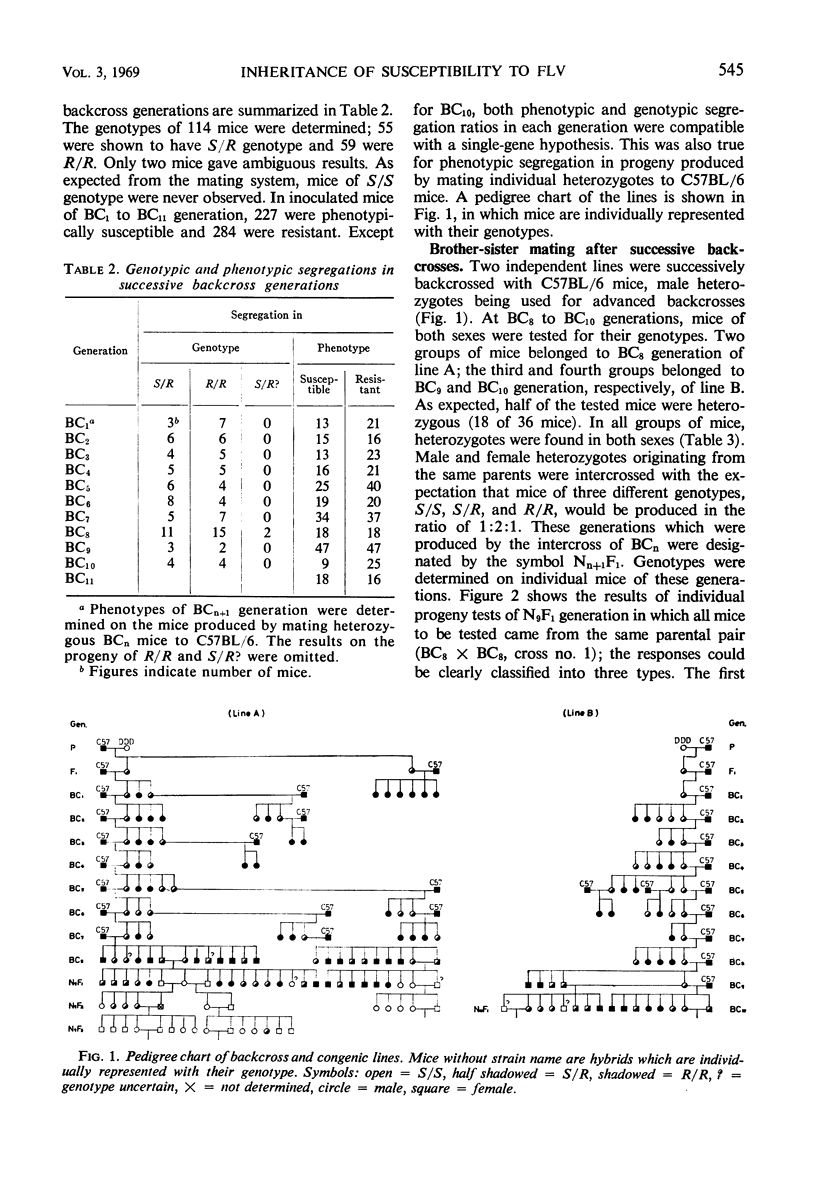Abstract
Based on the previous observation that a single major autosomal gene controls susceptibility to Friend leukemia virus in mice, an attempt was made to place the gene for susceptibility, Fvs, from susceptible DDD mice into the genetic complement of resistant C57BL/6 mice. The backcross system was adopted for this purpose, the heterozygotes being selected by progeny test at each generation. During successive backcrosses, the effect of gene Fvs was not diluted out, and progeny were almost always obtained as expected from the single-gene hypothesis, with respect to both genotype and phenotype. With the eighth backcross generation, brother-sister mating was done between the heterozygotes, and it produced mice homozygous for gene Fvs. These susceptible homozygotes and their progeny produced by incross could be assumed congenic with C57BL/6 mice except for susceptibility to Friend leukemia virus. The results indicate that the appearance of early splenomegaly in Friend virus-infected mice is under the control of a single major autosomal gene.
Full text
PDF





Selected References
These references are in PubMed. This may not be the complete list of references from this article.
- AXELRAD A. A., STEEVES R. A. ASSAY FOR FRIEND LEUKEMIA VIRUS: RAPID QUANTITATIVE METHOD BASED ON ENUMERATION OF MACROSCOPIC SPLEEN FOCI IN MICE. Virology. 1964 Nov;24:513–518. doi: 10.1016/0042-6822(64)90199-0. [DOI] [PubMed] [Google Scholar]
- Axelrad A. Genetic control of susceptibility to Friend leukemia virus in mice: studies with the spleen focus assay method. Natl Cancer Inst Monogr. 1966 Sep;22:619–629. [PubMed] [Google Scholar]
- Bang F. B., Warwick A. MOUSE MACROPHAGES AS HOST CELLS FOR THE MOUSE HEPATITIS VIRUS AND THE GENETIC BASIS OF THEIR SUSCEPTIBILITY. Proc Natl Acad Sci U S A. 1960 Aug;46(8):1065–1075. doi: 10.1073/pnas.46.8.1065. [DOI] [PMC free article] [PubMed] [Google Scholar]
- DAWE C. J. Cell sensitivity and specificity of response to polyoma virus. Natl Cancer Inst Monogr. 1960 Sep;4:67–128. [PubMed] [Google Scholar]
- FIELDSTEEL A. H., DAWSON P. J., BOSTICK W. L. Quantitative aspects of Friend leukemia virus in various murine hosts. Proc Soc Exp Biol Med. 1961 Dec;108:826–829. doi: 10.3181/00379727-108-27081. [DOI] [PubMed] [Google Scholar]
- FRIEND C. Cell-free transmission in adult Swiss mice of a disease having the character of a leukemia. J Exp Med. 1957 Apr 1;105(4):307–318. doi: 10.1084/jem.105.4.307. [DOI] [PMC free article] [PubMed] [Google Scholar]
- Franker C. K., Quilligan J. J., Jr Genetic aspects of resistance to Friend leukemia virus. Proc Soc Exp Biol Med. 1966 Apr;121(4):1090–1093. doi: 10.3181/00379727-121-30974. [DOI] [PubMed] [Google Scholar]
- Gröschel D., Koprowski H. Development of a virus-resistant inbred mouse strain for the study of innate resistance to Arbo B viruses. Arch Gesamte Virusforsch. 1965;17(3):379–391. doi: 10.1007/BF01241192. [DOI] [PubMed] [Google Scholar]
- HESTON W. E., DERINGER M. K. Further studies on the relationship between the genotype and the mammary tumor agent in mice. J Natl Cancer Inst. 1956 Jun;16(6):1309–1334. [PubMed] [Google Scholar]
- LILLY F., BOYSE E. A., OLD L. J. GENETIC BASIS OF SUSCEPTIBILITY TO VIRAL LEUKAEMOGENESIS. Lancet. 1964 Dec 5;2(7371):1207–1209. doi: 10.1016/s0140-6736(64)91043-8. [DOI] [PubMed] [Google Scholar]
- LINDENMANN J. INHERITANCE OF RESISTANCE TO INFLUENZA VIRUS IN MICE. Proc Soc Exp Biol Med. 1964 Jun;116:506–509. doi: 10.3181/00379727-116-29292. [DOI] [PubMed] [Google Scholar]
- Lilly F. The effect of histocompatibility-2 type on response to friend leukemia virus in mice. J Exp Med. 1968 Mar 1;127(3):465–473. doi: 10.1084/jem.127.3.465. [DOI] [PMC free article] [PubMed] [Google Scholar]
- MOLONEY J. B. Biological studies on a lymphoid-leukemia virus extracted from sarcoma 37. I. Origin and introductory investigations. J Natl Cancer Inst. 1960 Apr;24:933–951. [PubMed] [Google Scholar]
- ODAKA T., EDAKA T., YAMAMOTTO T. Inheritance of susceptibility to Friend mouse leukemia virus. Jpn J Exp Med. 1962 Oct;32:405–413. [PubMed] [Google Scholar]
- Odaka T. Inheritance of susceptibility to friend mouse leukemia virus. IV. Persistence of friend leukemia virus in C57BL-6 mice. Jpn J Exp Med. 1967 Feb;37(1):71–72. [PubMed] [Google Scholar]
- Odaka T., Yamamoto T. Inheritance of susceptibility to Friend mouse leukemia virus. 3. Susceptibility of F1 and genotypes of F2 and backcross progeny. Jpn J Exp Med. 1966 Feb;36(1):23–31. [PubMed] [Google Scholar]
- PRINCE A. M. Quantitative studies on Rous sarcoma virus. II. Mechanism of resistance of chick embryos to chorio-allantoic inoculation of Rous sarcoma virus. J Natl Cancer Inst. 1958 Apr;20(4):843–850. [PubMed] [Google Scholar]
- RAUSCHER F. J. A virus-induced disease of mice characterized by erythrocytopoiesis and lymphoid leukemia. J Natl Cancer Inst. 1962 Sep;29:515–543. [PubMed] [Google Scholar]
- Riley V., Lilly F., Huerto E., Bardell D. Transmissible Agent Associated with 26 Types of Experimental Mouse Neoplasms. Science. 1960 Aug 26;132(3426):545–547. doi: 10.1126/science.132.3426.545. [DOI] [PubMed] [Google Scholar]
- SCHELL K. Studies on the innate resistance of mice to infection with mousepox. II. Route of inoculation and resistance; and some observations on the inheritance of resistance. Aust J Exp Biol Med Sci. 1960 Aug;38:289–299. doi: 10.1038/icb.1960.30. [DOI] [PubMed] [Google Scholar]
- Sabin A. B. Nature of Inherited Resistance to Viruses Affecting the Nervous System. Proc Natl Acad Sci U S A. 1952 Jun;38(6):540–546. doi: 10.1073/pnas.38.6.540. [DOI] [PMC free article] [PubMed] [Google Scholar]


